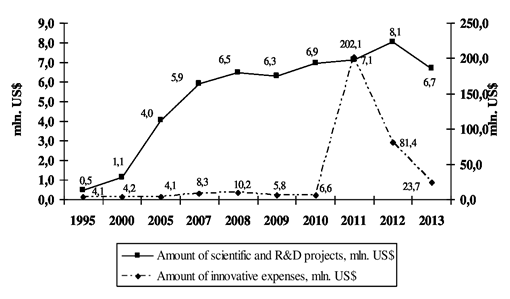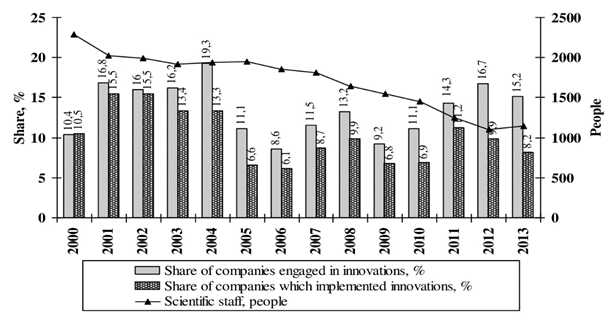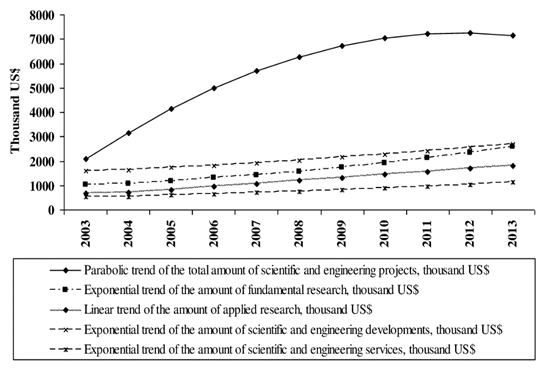Abstract
The paper reveals trends in the progressive development of the Republic of Crimea based on the monitoring of progressive activities. They make it possible to outline the prospects of the progressive growth by the relevant directions (power and transport complexes, social sphere, tourism and recreation, agriculture). Presents tables of statistical information. In order to forecast the level of the regional groundbreaking development under the conditions of lacking the statistic data and to validate the key directions for the economic politics in the groundbreaking sphere as well as to find the number factors which changing allows achieving the outlined results, the economic and mathematical simulation was made. Implemented econometric model of dependency of the indicators data. Data analysis was carried out on different groups and helped to identify the dependence of the structural components. It enables us to estimate the degree of influence of essential factors contributing to the increase of the progressive activity of the business entities on the scope of regional development activities.
Keywords: Progressive developmentmonitoringprogressive potentialprogressive activityregion
Introduction
The uniqueness of the modern progressive situation in the Republic of Crimea is in that, on the one hand, there are great fundamental and technological capacities, skilled scientists and engineers, developed scientific and production facilities, in some directions unrivaled; on the other hand – utterly poor focus of this important element on implementation in real innovations. Insufficient use of the progressive potential of the region; the absence of the practical mechanism for stimulation and support of the progressive entities; an increased amount of information and limited capabilities for its interpretation make urgent the necessity of monitoring progressive activities of enterprises in the Crimean Peninsula and rich of the practical recommendations aimed at optimal ratio of investment and the ground breaking potential of participants of the groundbreaking activities for their reason able application.
Monitoring is made by systematic observations for development of the progressive processes, analysis and forecast of changes in the course of time as well as assessment of trends in the progressive development to form adequate economic and social programs (Iokhna, 2005).
For this purpose, the key prerequisite for the successful progressive development is activation of the progressive process providing implementation of the priority progressive projects and consolidation of competitiveness of the enterprises. In their turn, the companies being the carriers of the competitive benefits make the base for the competitive success not only in the sphere defined by their business but in all the branches of the regional economy (Arvanitis, 2002; Nyrkov, 2016).
Methods
The dynamics of factor change and analysis
AccordingtothepollingsurveyamongthedirectorsoftheleadingCrimeancompanies, themajorreasonforrefusingtheimplementationofpromisingprogressivedevelopmentsintotheproductionislackofself-financing (profit; capabilities for encourage in ginner assets, monetary portion of charges of company owners) the early 2000s, equity funds were predominant in the structure of progressive expenses, in 2013,the share of own financial resources reduced more than 80 %, but the share of other sources for funding increased from 0.1 % up to 59.9 % (Fig. 1).
![Structure of sources of funding progressive activities of Crimean companies, % [4].](https://www.europeanproceedings.com/files/data/article/57/2000/icRRIF2016071.fig.001.jpg)
The almost complete lack of state support for innovation and the reluctance of foreign businesses to make financial investments in the Republic of Crimea (because of sanctions) to attract the attention of local authorities on the need for funding of innovative projects (25% of the total amount of the progressive expenses was allocated from the local budget in 2013). In particular, the increase in costs was observed in 2011. About 88.2 % of these expenditures were submitted for the purchase of machinery, equipment and software. Regional development in the period of sanctions rather difficult. State support is extremely important for such regions. Investment in support of the region is provided by the government of the Russian Federation. In its turn, it resulted in an increased amount of scientific and R&D activities made by institutions on their own (Fig. 2).

Considering the large outflow of scientific personnel (by factor of 2.6 for 1995-2013), since wages are low among research workers and the "age" barrier for comprehensive scientific research (50 % specialists with degree of Dr.Scn. were above 61 years and older), attention must be paid On the growth of modern active industrial enterprises in the region (from 11.9% to 15.2% in the total volume of industrial enterprises). These enterprises, mainly related to the production of food products, including beverages, and tobacco products, electronics and optical instruments, engineering, as well as the production and distribution of electricity, gas and water, are the main participants of a more marginal process in the region. It should be noted a certain disproportion in the dynamics of the development of modern innovative active companies in the regional market can be observed.
An enlarged share of progressive active companies unfortunately does not result in the increased share of the companies that implement innovations, a number of which reduced from 10.5 % down to 8.2 % for 2000-2013 (Fig. 3). Theoretical aspects of the development of cruise tourism is historically based on a comparison of categories of "cruise" and the sea voyage "as a form of transport cruise tourists Services organization (Iokhna, 2005) with many specific properties (Nyrkov, 2016), as well as bringing together companies and organizations involved in the process of establishing cruise tourism products (http://gosstat.crimea.ru/).

At the same time, studying the history of the origin and current state of development of cruise tourism (Aguirre, 2008), classification features and technical components of the cruise ships (Diedrich, 2010) and the organization of the cruise service allowing for the perception of sea cruises by certain categories of cruise ship passengers (Chase, 2002), most authors do not protrude the details of the organization of the coastal service of cruise tourists.
Practical questions of the organization of cruise tourism are reflected in the works (Loizidou, 2016; Bentz, 2016; Wu, 2016; Golikov, 2015), in which scientists systematize the principles of the cruise lines (Loizidou, 2016), analyze the geography of the cruise activities and features of vessels intended for sailing cruise (Bentz, 2016). These publications are studied factors and patterns of structuring the global cruise market (Wu, 2016), as well as issues of modeling passenger cruise rates shipowner (Wu, 2016; Golikov, 2015) and conditions of agency cruise ships.
Recognizing the high scientific importance of the work performed by theabove-mentioned authors, it should be noted that the available studies remain understudied problem of ensuring effective development of cruise tourism. At the same time, considering the effectiveness of cruise tourism, scientists imply the existence of three types of effect: the economic, social and environmental (Chernyi, 2016; Butler, 2003). However, the complex influence of these types of effects on the effectiveness of the functioning of the cruise industry is not taken into consideration.
Further development requires methodological bases of the organization of cruise tourism, as well as methodological approaches to assessing the level of development of cruise tourism and the practical aspects of increasing the efficiency of its functioning. For example, in (http://gosstat.crimea.ru/; Wu, 2016), these issues are reflected only in fragments, without taking into account the specifics of functioning of the Ukrainian cruise market, and especially the establishment of the cruise tourism product for domestic consumers.
Characteristic of the development process in the region
Analytical graduation of the dynamics of the annual scales of the progressive activities by the Crimean companies for the last decade made it possible to specify the trends of their progressive development. Figure

Thus, contrasted with the general positive dynamics of the progressive development of the companies in the Republic of Crimea, the amount of the sold progressive products tended to reduction. It proves cutting down in demand for innovations among the population and other institutions and necessitates the comprehensive study of market requirements and correct evaluation of the market situation. The major targets in this study are as follows: analysis of consumers of innovations with their differentiation under demographic, social and economic, geographical, psychological and psycho graphical criteria (Aguirre, 2008). A progressive item of goods should be studied in detail in order to match the information about its technical, operational and other specific features as well as capabilities for the formation of the added user value (Butler, 2003; Camire, 2008).
Analysis of the conditions of the company activity under the given methodology indicates the directions for generating ideas concerning ways to meet the public demand with respect to capabilities of a certain economic entity and consequently serves as a basis for planning its progressive activity in long-term and short-term (1-2 years) periods.
Let us take into consideration the most important factors contributing to the growth of the progressive activity of companies (the general social and economic level of development, availability of skilled staff, investments to the capital facilities, the level of education of population). These can be used in order to forecast the level of progressive development of the region under the condition of lack of statistical information and validation of the key trends of the economic policy in the progressive sphere, as well as to find the quantity parameters, changing which one can achieve the desired outputs. Thus, economic and mathematic simulation was made based on elaboration of the regression-estimated equation. This equation enables one to assess the impact degree of the number of students of higher education institutions per 1000 people (
(1)
Estimations according to the developed pattern demonstrated that a number of university students per 1000 people have the greatest impact on the volume of scientific and engineering activities (Camire, 2008; Junxiang, 2011; Cambron, 2016; Camire, 2008; Junxiang, 2011; Cambron, 2016).
The enlarged number of these students for 1 % results in the increased volume of innovations for 1.07 %. The level of labor productivity is expressed through the indicator of gross regional product in relation to one worker in public production and has a big impact. Its increase for 1 % contributes to growth of scientific and engineering technologies made by companies on their own for 0.92 %.
Results
The calculations made according to the composed equation have demonstrated that the most impact on the volume of implemented scientific and scientific and technical works is made by the number of students of higher institutions per 1000 people. Its growth by 1 %causes an increase of the number of innovation development works by 1.07 % (RosStat, 2016). The level of productivity of employees, expressed through the index of the gross regional product per one employed in the social production, the 1 % rise of which enables the 0.92 % increase of the scientific and scientific and technical works, performed by organizations on their own, exert the same amount of influence. This fact fully correlates with the commonly accepted attitude on the importance of the most significant resource of any state – human being. A particular importance for activation of the innovation activity of enterprises belongs to the share of scientific workers per the number of economically active population. This fact is confirmed by the parameters of the regression equation (by the coefficient when
Therewith, despite the general positive dynamics, one may talk about breakthrough only in the case the synergetic effect will be achieved due to the development of innovations and high technologies in the scientific and higher educational institutions (Junxiang, 2011; Cambron, 2016; Hu, 2012).
Conclusion
One of the ways to increase the progressive activities of companies in the region is to create a regional progressive cluster by combining relevant companies, scientific and research organizations, governmental and financial institutions in a certain sphere (recreation and tourism, fuel and energy, social, etc.). This cluster would contribute to the efficient use of competitive benefits and provide effective progressive development of the region based on the synergetic cooperation of all the participants. Building up the model of functioning the progressive cluster should be based on certain quality parameters.They are coherence of the cluster, which characterizes the level of mutual influence of its components as well as their access to the necessary resources; the effect of synergy representing a set of potentials of the cluster participants; a cluster basic element making a main contribution to the organization of interactions and being a driving motive of the system; a cluster nuclei comprising the organizations providing the main output of its performance; reserves of increase. The value of the investment is very important to support the regions which are under sanctions.
References
- Aguirre, S.Z. &Brida, J. G. (2008). The impacts of the cruise industry on tourism destinations.Sustainable tourism as a factor of local development.Tangram EdizioniScientifiche, Available at: http://papers.ssrn.com/sol3/papers.cfm?abstract_id=1298403
- Arvanitis, S., Hollenstein, H. & Lenz, S. (2002). The Effectiveness of Government Promotion of Advanced Manufacturing Technologies (AMT): An Economic Analysis Based on Swiss Micro Data. Small Business Economics, 19-4, 321–340.
- Bentz, J., Lopes, F., Calado, H., &Dearden, P. (2016). Sustaining marine wildlife tourism through linking Limits of Acceptable Change and zoning in the Wildlife Tourism Model. Marine Policy, 68, 100-107.
- Butler, M. (2003). Worldwide Cruise Ship Activity.World Tourism Organization, 216.
- Cambron, P.,Lepvrier, R., Masson, C.,Tahan, A. &Pelletier, F. (2016).Power curve monitoring using weighted moving average control charts. Renewable Energy, 94, 126-135.
- Camire, D. (2008). Rule change could alter cruise industry. The Honolulu Advertiser. 11, 1–2.
- Chase, G. &Alon, I. (2002). Evaluating the economic impact of cruise tourism: a case study of Barbados. An International Journal of Tourism and Hospitality Research. 13-1, 5–18.
- Chernyi, S. (2016). Use of Information Intelligent Components for the Analysis of Complex Processes of Marine Energy Systems. Transport And Telecommunication Journal, 17(3).
- Diedrich, A. (2010). Cruise ship tourism in Belize: The implications of developing cruise ship tourism in an ecotourism destination. Ocean and Coastal Management. 53, 234–244.
- Golikov, S., Logunova, N. &Chernyi, S. (2015). Metallurgical and Mining Industry, 7-11, 202-206.
- Hu, L., Cai, C., Tian, X., Fan, Y., Jia, J., & Wei, C. (2012). Run Real-Time Monitoring of Wind Power Generation System Based on WSN. Advanced Materials Research, 588-589, 587-590.
- Iokhna, M.A. (2005). Ekonomika I organizatsiyainnovatsiynoyidiyalnosti (Economics and organization of the progressive activity: manual).Publishing Center Academy
- Junxiang, G. &Jingtao, X. (2011).Fruit Cold Storage Environment Monitoring System Based on Wireless Sensor Network. Procedia Engineering, 15, 3466-3470.
- Lee, T. & Hsieh, H. (2016). Indicators of sustainable tourism: A case study from a Taiwan's wetland. Ecological Indicators, 67, 779-787.
- Loizidou, X., Loizides, M., &Orthodoxou, D. (2016). Marine strategy framework directive: Defining joint monitoring opportunities for the Eastern Mediterranean and the Black Sea, through dedicated decision making workshops and progressive policy tools. Marine Policy, 67, 76-82.
- Nyrkov, A., Budnik, V., Sokolov, S., &Chernyi, S. (2016). The Algorithm of Development the World Ocean Mining of the Industry During the Global Crisis. IOP Conference Series: Materials Science And Engineering, 142, 012121.
- Retrieved from URLhttp://gosstat.crimea.ru/
- Wu, C. & Tsai, H. (2016). Capacity building for tourism development in a nested social–ecological system—A case study of the South Penghu Archipelago Marine National Park, Taiwan. Ocean & Coastal Management, 123, 66-73.
Copyright information

This work is licensed under a Creative Commons Attribution-NonCommercial-NoDerivatives 4.0 International License.
About this article
Publication Date
20 July 2017
Article Doi
eBook ISBN
978-1-80296-025-9
Publisher
Future Academy
Volume
26
Print ISBN (optional)
Edition Number
1st Edition
Pages
1-1055
Subjects
Business, public relations, innovation, competition
Cite this article as:
Logunova, N. A., Antypenko, I. V., Babina, O. V., & Selivan, A. Y. (2017). System analysis evaluation of regional development. In K. Anna Yurevna, A. Igor Borisovich, W. Martin de Jong, & M. Nikita Vladimirovich (Eds.), Responsible Research and Innovation, vol 26. European Proceedings of Social and Behavioural Sciences (pp. 557-564). Future Academy. https://doi.org/10.15405/epsbs.2017.07.02.71

